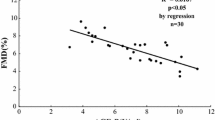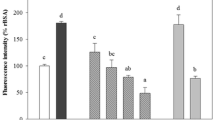Abstract
The present study was designed to investigate the role of advanced glycation end products (AGEs) in intermediate-conductance and small-conductance Ca2+-activated potassium channels (KCa3.1 and KCa2.3)-mediated relaxation in rat resistance arteries and the underlying mechanism. The endothelial function of mesenteric arteries was assessed with the use of wire myography. Expression levels of KCa3.1 and KCa2.3 were measured by using Western blot. Reactive oxygen species (ROS) were measured by using dihydroethidium and 2′, 7′-dichlorofluorescein diacetate. KCa3.1 and KCa2.3-mediated vasodilatation responses to acetylcholine and NS309 (opener of KCa3.1 and KCa2.3) were impaired by incubation of the third-order mesenteric arteries from normal rats with AGEs (200 μg ml−1 for 3 h). In cultured human umbilical vein endothelial cells (HUVECs), AGEs increased ROS level and decreased the protein expression of KCa3.1 and KCa2.3. Antioxidant alpha lipoic acid restored the impairment in both vasodilatation function and expression of KCa3.1 and KCa2.3. H2O2 could mimic the effect of AGEs on the protein expression of KCa3.1 and KCa2.3 in cultured HUVECs. These results demonstrate for the first time that AGEs impaired KCa3.1 and KCa2.3-mediated vasodilatation in rat mesenteric arteries via downregulation of both KCa3.1 and KCa2.3, in which the enhanced oxidative stress was involved.






Similar content being viewed by others
References
Bashan N, Kovsan J, Kachko I, Ovadia H, Rudich A (2009) Positive and negative regulation of insulin signaling by reactive oxygen and nitrogen species. Physiol Rev 89:27–71
Brakemeier S, Eichler I, Knorr A, Fassheber T, Köhler R, Hoyer J (2003) Modulation of Ca2+-activated K+ channel in renal artery endothelium in situ by nitric oxide and reactive oxygen species. Kidney Int 64:199–207
Brähler S, Kaistha A, Schmidt VJ, Wölfle SE, Busch C, Kaistha BP, Kacik M, Hasenau AL, Grgic I, Si H, Bond CT, Adelman JP, Wulff H, de Wit C, Hoyer J, Köhler R (2009) Genetic deficit of SK3 and IK1 channels disrupts the endothelium-derived hyperpolarizing factor vasodilator pathway and causes hypertension. Circulation 119:2323–2332
Brondum E, Kold-Petersen H, Simonsen U, Aalkjaer C (2009) NS309 restores EDHF-type relaxation in mesenteric small arteries from type 2 diabetic ZDF rats. Br J Pharmacol 159:154–165
Busse R, Edwards G, Feletou M, Fleming I, Vanhoutte PM, Weston AH (2002) EDHF: bringing the concepts together. Trends Pharmacol Sci 23:374–380
Bychkov R, Pieper K, Ried C, Milosheva M, Bychkov E, Luft FC, Haller H (1999) Hydrogen peroxide, potassium currents, and membrane potential in human endothelial cells. Circulation 99:1719–1725
Burnham MP, Johnson IT, Weston AH (2006) Impaired small conductance Ca2+-activated K+ channel-dependent EDHF responses in type II diabetic ZDF rats. Br J Pharmacol 148:434–441
Cai S, Sauve R (1997) Effects of thiol-modifying agents on a KCa channel of intermediate conductance in bovine aortic endothelial cells. J Membr Biol 158:147–158
Ding H, Hashem M, Wiehler WB, Lau W, Martin J, Reid J, Triggle C (2005) Endothelial dysfunction in the streptozotocin-induced diabetic apoE-deficient mouse. Br J Pharmacol 146:1110–1118
Dora KA, Gallagher NT, McNeish A, Garland CJ (2008) Modulation of endothelial cell KCa3.1-channels during EDHF signaling in mesenteric resistance arteries. Circ Res 102:1247–1255
Duprat F, Guillemare E, Romey G, Fink M, Lesage F, Lazdunski M, Honore E (1995) Susceptibility of cloned K+ channels to reactive oxygen species. Proc Natl Acad Sci U S A 92:11796–11800
Edwards G, Feletou M, Weston AH (2010) Endothelium-derived hyperpolarising factors and associated pathways: a synopsis. Pflugers Arch 459:863–879
Eichler I, Wibawa J, Grgic I, Knorr A, Brakemeier S, Pries AR, Hoyer J, Köhler R (2003) Selective blockade of endothelial Ca2+-activated small- and intermediate-conductance K+-channels suppresses EDHF-mediated vasodilation. Br J Pharmacol 138:594–601
Endemann DH, Schiffrin EL (2004) Nitric oxide, oxidative excess, and vascular complications of diabetes mellitus. Curr Hypertens Rep 6:85–89
Félétou M, Vanhoutte PM (2009) EDHF: an update. Clin Sci (Lond) 117:139–155
Gao X, Zhang H, Schmidt AM, Zhang C (2008) AGE/RAGE produces endothelial dysfunction in coronary arterioles in type 2 diabetic mice. Am J Physiol Heart Circ Physiol 295:H491–H498
Goldin A, Beckman JA, Schmidt AM, Creager MA (2006) Advanced glycaton end products: sparking the development of diabetic vascular injury. Circulation 114:597–605
Grgic I, Kaistha BP, Hoyer J, Kohler R (2009) Endothelial Ca2+ -activated K+ channels in normal and impaired EDHF-dilator responses-relevance to cardiovascular pathologies and drug discovery. Br J Pharmacol 157:509–526
Hartge MM, Kintscher U, Unger T (2006) Endothelial dysfunction and its role in diabetic vascular disease. Endocrinol Metab Clin North Am 35:551–560
He M, Siow RC, Sugden D, Gao L, Cheng X, Mann GE (2011) Induction of HO-1 and redox signaling in endothelial cells by advanced glycation end products: a role for Nrf2 in vascular protection in diabetes. Nutr Metab Cardiovasc Dis 21:277–285
Kourie JI (1998) Interaction of reactive oxygen species with ion transport mechanisms. Am J Physiol 275:C1–C24
Lee JJ, Hsiao CC, Yang IH, Chou MH, Wu CL, Wei YC, Chen CH, Chuang JH (2012) High-mobility group box 1 protein is implicated in advanced glycation end products-induced vascular endothelial growth factor A production in the rat retinal ganglion cell line RGC-5. Mol Vis 18:838–850
Leo CH, Hart JL, Woodman OL (2011) Impairment of both nitric oxide-mediated and EDHF-type relaxation in small mesenteric arteries from rats with streptozotocin- induced diabetes. Br J Pharmacol 162:365–377
Li R, McCourt P, Schledzewski K, Goerdt S, Moldenhauer G, Liu X, Smedsrød B, Sørensen KK (2009) Endocytosis of advanced glycation end-products in bovine choriocapillaris endothelial cells. Microcirculation 16:640–655
Mamputu JC, Renier G (2004) Advanced glycation end-products increase monocyte adhesion to retinal endothelial cells through vascular endothelial growth factor-induced ICAM-1 expression: inhibitory effect of antioxidants. J Leukoc Biol 75:1062–1069
McPherson GA (1992) Assessing vascular reactivity of arteries in the small vessel myograph. Clin Exp Pharmacol Physiol 19:815–825
Morikawa K, Matoba T, Kubota H, Hatanaka M, Fujiki T, Takahashi S, Takeshita A, Shimokawa H (2005) Influence of diabetes mellitus, hypercholesterolemia, and their combination on EDHF-mediated responses in mice. J Cardiovasc Pharmacol 45:485–490
Morimura K, Yamamura H, Ohya S, Imaizumi Y (2006) Voltage-dependent Ca2+-channel block by openers of intermediate and small conductance Ca2+-activated K+ channels in urinary bladder smooth muscle cells. J Pharmacol Sci 100:237–241
Negre-Salvayre A, Salvayre R, Augé N, Pamplona R, Portero-Otín M (2009) Hyperglycemia and glycation in diabetic complications. Antioxid Redox Signal 11:3071–3109
Rahman S, Rahman T, Ismail AA, Rashid AR (2007) Diabetes-associated macrovasculopathy: pathophysiology and pathogenesis. Diabetes Obes Metab 9:767–780
Sena CM, Matafome P, Crisóstomo J, Rodrigues L, Fernandes R, Pereira P, Seiça RM (2012) Methylglyoxal promotes oxidative stress and endothelial dysfunction. Pharmacol Res 65:497–506
Sheng JZ, Ella S, Davis MJ, Hill MA, Braun AP (2009) Openers of SKCa and IKCa channels enhance agonist-evoked endothelial nitric oxide synthesis and arteriolar vasodilation. FASEB J 23:1138–1145
Si H, Heyken WT, Wölfle SE, Tysiac M, Schubert R, Grgic I, Vilianovich L, Giebing G, Maier T, Gross V, Bader M, de Wit C, Hoyer J, Köhler R (2006) Impaired endothelium-derived hyperpolarizing factor-mediated dilations and increased blood pressure in mice deficient of the intermediate-conductance Ca2+-activated K+ channel. Circ Res 99:537–544
Taylor MS, Bonev AD, Gross TP, Eckman DM, Brayden JE, Bond CT, Adelman JP, Nelson MT (2003) Altered expression of small-conductance Ca2+-activated K+ (SK3) channels modulates arterial tone and blood pressure. Circ Res 93:124–131
Tokube K, Kiyosue T, Arita M (1996) Openings of cardiac KATP channel by oxygen free radicals produced by xanthine oxidase reaction. Am J Physiol 27:H478–H489
Vanhoutte PM, Shimokawa H, Tang EHC, Feletou M (2009) Endothelial dysfunction and vascular disease. Acta Physiol 196:193–222
Vlassara H, Uribarri J, Cai W, Striker G (2008) Advanced glycation end product homeostasis: exogenous oxidants and innate defenses. Ann NY Acad Sci 1126:46–52
Wang CY, Liu HJ, Chen HJ, Lin YC, Wang HH, Hung TC, Yeh HI (2011) AGE-BSA down-regulates endothelial connexin43 gap junctions. BMC Cell Biol 12:19. doi:10.1186/1471-2121-12-19
Weston AH, Absi M, Harno E, Geraghty AR, Ward DT, Ruat M, Dodd RH, Dauban P, Edwards G (2008) The expression and function of Ca2+-sensing receptors in rat mesenteric artery; comparative studies using a model of type II diabetes. Br J Pharmacol 154:652–662
Wigg SJ, Tare M, Tonta MA, O’Brien RC, Meredith IT, Parkington HC (2001) Comparison of effects of diabetes mellitus on an EDHF dependent and an EDHF- independent artery. Am J Physiol Heart Circ Physiol 281:H232–H240
Wulff H, Castle NA (2010) Therapeutic potential of KCa3.1 blockers: recent advances and promising trends. Expert Rev Clin Pharmacol 3:385–396
Yamagishi S, Nakamura K, Imaizumi T (2005) Advanced glycation end products (AGEs) and diabetic vascular complications. Curr Diabetes Rev 1:93–106
Zhao LM, Zhang W, Wang LP, Li GR, Deng XL (2012) Advanced glycation end products promote proliferation of cardiac fibroblasts by upregulation of KCa3.1 channels. Pflugers Arch 464:613–621
Acknowledgments
This work was supported by the National Natural Science Foundation of China (grant number 81100231, 81170137 and 81200097) and the Natural Science Foundation of Shaanxi Province (grant number 2011JQ4021). The authors are grateful for substantial support from Professor Lang-Chong He, School of Medicine, Xi’an Jiaotong University.
Conflict of interest
The authors have no conflicts of interest to disclose.
Author information
Authors and Affiliations
Corresponding author
Rights and permissions
About this article
Cite this article
Zhao, LM., Wang, Y., Ma, XZ. et al. Advanced glycation end products impair KCa3.1- and KCa2.3-mediated vasodilatation via oxidative stress in rat mesenteric arteries. Pflugers Arch - Eur J Physiol 466, 307–317 (2014). https://doi.org/10.1007/s00424-013-1324-y
Received:
Revised:
Accepted:
Published:
Issue Date:
DOI: https://doi.org/10.1007/s00424-013-1324-y




